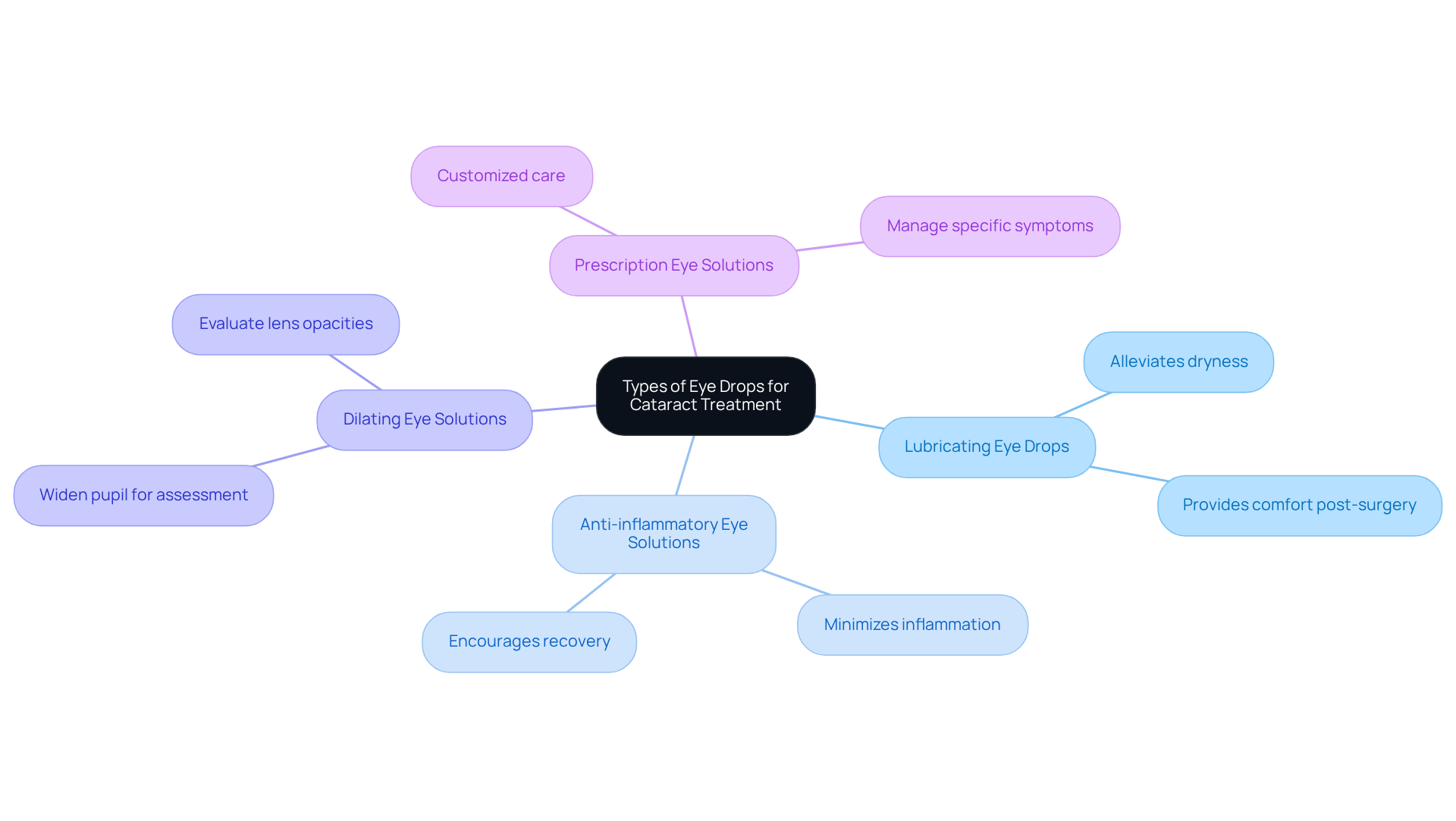Posted by: Northwest Eye in Cataracts on November 10, 2025
Overview
Managing cataracts can feel overwhelming, and we understand that you may have many questions and concerns. This article focuses on the application and care tips for eye drops that play a crucial role in alleviating symptoms and preparing for potential surgical intervention.
Eye drops can be a vital part of your treatment plan. They help ease discomfort and improve your quality of life. There are various types of eye drops available, and knowing how to apply them correctly is essential. We’ll guide you through proper application techniques, ensuring you feel confident in your care routine.
It’s also important to monitor any side effects you may experience. Keeping track of how your eyes respond can enhance your comfort and ensure effective treatment outcomes. Remember, it’s common to feel uncertain about what to expect, but you’re not alone in this journey.
Here are some key tips to keep in mind:
- Follow the prescribed dosage: Stick to the schedule your doctor provides.
- Apply drops correctly: Tilt your head back, pull down your lower eyelid, and place the drop in the pocket created.
- Monitor for side effects: If you notice anything unusual, reach out to your healthcare provider.
We are here to help you through this process, and we encourage you to reach out with any questions. Your comfort and well-being are our top priorities. Together, we can navigate this journey towards better eye health.
Introduction
Cataracts can truly cast a shadow over daily life, often leading to blurred vision and making nighttime activities more challenging. We understand that as this common condition progresses, it’s essential to know how eye drops can play a pivotal role in managing symptoms and maintaining your quality of life. With so many options available and the intricacies of proper application, it’s common to feel overwhelmed.
This article will explore the types of eye drops available for cataract care, effective application techniques, and tips for managing any side effects. Our goal is to empower you to take charge of your eye health journey, providing you with the knowledge and support you need.
Explore Cataracts and the Role of Eye Drops
Cataracts are a common eye condition that many people face, often leading to blurred vision and difficulty seeing at night. We understand that this gradual change can significantly impact your daily activities and overall quality of life. Eye solutions play an essential role in managing symptoms related to lens opacity, especially in the early stages. They can help alleviate discomfort, reduce inflammation, and prepare your eyes for potential surgical intervention. Understanding the characteristics of lens opacity and the role of eye drops for cataracts is crucial for you to actively participate in your treatment journey and make informed choices about your eye health.
At Northwest Eye, our lens surgeons emphasize the importance of personalized lens selection to enhance your visual outcomes. With advanced options like the Light Adjustable Lens, which allows for customizable vision correction, and various astigmatism-correcting technologies, you can benefit from tailored solutions that address your specific vision needs. Recent research, including findings from the case study ‘Dissolving Cataracts with Eye Solutions Instead of Surgery,’ suggests that eye solutions containing lanosterol may even help slow the progression of lens opacity. With forecasts indicating that more than 30 million individuals will experience clouded lenses by 2028, it’s important to recognize that this condition becomes more common with age, affecting 68.3% of people aged 80 and above.
Ophthalmologists highlight that while eye drops for cataracts are not a cure, they are vital in improving comfort and preserving your eye health. Routine eye check-ups are essential for monitoring the development of lens clouding and ensuring timely action. Actively participating in your treatment journey, including understanding the purpose of eye solutions and the options available for lens selection, empowers you to make informed choices about your eye care. Remember, we are here to help you through this process.

Identify Types of Eye Drops for Cataract Treatment
When it comes to cataract treatment, several types of eye drops are commonly recommended, each serving a specific purpose that can make a real difference in your comfort and recovery:
- Lubricating Eye Drops: These drops are essential for alleviating dryness and irritation, offering significant comfort to those experiencing symptoms associated with cataracts. You can use them for extended periods, especially after surgery, to help manage dryness as your eye heals.
- Anti-inflammatory Eye Solutions: Often recommended following lens replacement surgery, these solutions play a crucial role in minimizing inflammation and encouraging recovery. They’re vital for ensuring a smooth recovery and improving visual outcomes within days to weeks after the procedure.
- Dilating Eye Solutions: Used during eye assessments, these solutions help ophthalmologists evaluate the severity of lens opacities and decide on the best treatment strategy. They temporarily widen the pupil, allowing for a clearer view of the eye’s internal structures.
- Prescription Eye Solutions: In some cases, specific prescribed solutions may be suggested to manage symptoms or prepare for surgery. These tailored solutions can address particular concerns related to lens opacity, ensuring you receive customized care that meets your needs.
We understand that navigating these choices can feel overwhelming. Comprehending these options enables you to engage in informed conversations with your eye doctor, helping you choose the most suitable eye solutions for your unique circumstances. Furthermore, considering innovative therapies like the Light Adjustable Lens (LAL) can enhance personalized care in eye surgery, allowing for adjustments post-operation to optimize your vision results. Remember, we are here to help you through this process.

Apply Eye Drops Correctly for Optimal Results
To ensure the effective application of eye drops, especially for those recovering from cataract surgery with innovative solutions like the Light Adjustable Lens (LAL), we understand that following these essential steps can make a difference:
- Wash Your Hands: Begin by thoroughly washing your hands to eliminate any bacteria that could lead to infections. This simple step is crucial for your safety.
- Shake the Bottle: If you’re using a suspension liquid, gently shake the bottle to ensure the solution is well mixed. This helps in delivering the right dosage.
- Tilt Your Head Back: Look up at the ceiling and slightly tilt your head back. This position creates a better angle for application, making it easier for you.
- Pull Down Your Lower Eyelid: Use your index finger to gently pull down your lower eyelid, forming a small pocket to receive the liquid. This step is important for effective application.
- Administer the Drop: Hold the dropper above your eye without touching the eye or eyelid. Squeeze the bottle gently to release a single bead into the pocket formed by your lower eyelid. Remember, it’s okay to take your time.
- Shut Your Eye: After applying the solution, shut your eye gently for about a minute. This allows the medication to absorb effectively. Avoid blinking or squeezing your eyelids tightly during this time; it’s a moment for your eye to relax.
- Remove Surplus: If any liquid spills out, use a clean tissue to gently remove the surplus fluid. This keeps your experience comfortable.
- Repeat if Needed: If several applications are required, wait at least five minutes before administering the next dose. This ensures the first one isn’t rinsed away.
Adhering to these steps is essential for enhancing the efficacy of eye drops, especially for individuals recovering from lens surgery using LAL technology. Proper application techniques not only enhance moisture retention but also significantly reduce discomfort and improve overall eye health. Research shows that approximately 88% of individuals undergoing lens surgery utilize eye medications, highlighting their essential role in post-operative care. By following these guidelines, you can guarantee optimal healing and long-term eye comfort. We are here to help you through this process.

Manage Side Effects and Post-Application Care
After applying eye drops, it’s common for patients to experience a few side effects. We understand that this can be concerning, so let’s take a closer look at what you might encounter:
-
Temporary Blurriness: It’s not unusual to have blurred vision right after using eye drops. This can happen due to various reasons, like uncorrected refractive errors or conditions such as cataracts and diabetic retinopathy. Most people find that their vision clears up within a few minutes. However, it’s wise to wait before jumping back into activities that require clear sight.
-
Stinging or Burning Sensation: Some individuals may feel a mild stinging or burning when they apply the drops. This sensation typically fades quickly, but if it lingers, it’s important to reach out to your ophthalmologist. As Dr. Gregory Cox wisely notes, “Grasping the significance of each medication can encourage individuals to follow their regimen.”
-
Redness or Irritation: If you notice ongoing redness or irritation, it could indicate a reaction to the solution. Should these symptoms persist, please consult your eye care provider for guidance. Many patients also report that sensitivity to bright lights can add to their blurred vision, which can be quite distressing.
To help manage these side effects and support your recovery:
- Avoid Rubbing Your Eyes: Rubbing can aggravate irritation and increase the risk of infection by introducing bacteria.
- Follow Up with Your Doctor: Regular check-ins with your doctor are essential for monitoring your eye health and making any necessary adjustments to your treatment plan. As leading eye specialists emphasize, “Successful recovery after lens surgery doesn’t solely rely on the procedure itself; it also includes how diligently you adhere to your eye medication routine.”
- Store Eye Solutions Properly: Keep your eye solutions in a cool, dry place, and regularly check expiration dates to ensure they remain effective.
Understanding and managing these aspects can significantly enhance your comfort and ensure the effectiveness of your cataract treatment, especially when using eye drops for cataracts. By maintaining a consistent routine with your eye drops for cataracts and being aware of potential side effects, you can pave the way for a smoother recovery process. Remember, we are here to help you through this journey.

Conclusion
Understanding the role of eye drops in managing cataracts is vital for anyone experiencing this common eye condition. We understand that cataracts can lead to significant vision impairment, and utilizing the right eye solutions can alleviate symptoms and enhance comfort. This knowledge paves the way for informed decision-making in your eye care journey. While eye drops may not cure cataracts, they serve as an essential tool in improving quality of life and preparing for potential surgical interventions.
Throughout this article, we’ve discussed various types of eye drops, including:
- Lubricating
- Anti-inflammatory
- Dilating
- Prescription solutions
Each type plays a unique role in cataract treatment. Proper application techniques ensure that these drops are effective, and understanding potential side effects helps manage expectations during recovery. Regular consultations with an eye care professional can further optimize treatment and enhance visual outcomes.
Ultimately, staying proactive about eye health and educating yourself on cataract treatment options is crucial. By mastering the application and care of eye drops, you can significantly improve your comfort and recovery process. Embracing this knowledge not only empowers you but also underscores the importance of active participation in your eye care journey. Remember, we are here to help you through this process.
Frequently Asked Questions
What are cataracts and how do they affect vision?
Cataracts are a common eye condition that leads to blurred vision and difficulty seeing at night. They cause gradual changes in vision, significantly impacting daily activities and overall quality of life.
How can eye drops help with cataracts?
Eye drops play an essential role in managing symptoms related to lens opacity, especially in the early stages. They can alleviate discomfort, reduce inflammation, and prepare the eyes for potential surgical intervention.
What is the significance of personalized lens selection for cataract treatment?
Personalized lens selection is important for enhancing visual outcomes. Advanced options like the Light Adjustable Lens allow for customizable vision correction, addressing specific vision needs.
Is there any research suggesting that eye solutions can help with cataracts?
Yes, recent research, including a case study titled ‘Dissolving Cataracts with Eye Solutions Instead of Surgery,’ suggests that eye solutions containing lanosterol may help slow the progression of lens opacity.
How common are cataracts, and who is most affected?
Cataracts are expected to affect more than 30 million individuals by 2028, becoming more common with age. Approximately 68.3% of people aged 80 and above are affected by this condition.
Are eye drops a cure for cataracts?
No, eye drops for cataracts are not a cure, but they are vital in improving comfort and preserving eye health.
Why are routine eye check-ups important for cataract management?
Routine eye check-ups are essential for monitoring the development of lens clouding and ensuring timely action to address any changes in vision.
How can patients actively participate in their cataract treatment journey?
Patients can actively participate by understanding the purpose of eye solutions, exploring options for lens selection, and making informed choices about their eye care.






